Lyudmila Pavlichenko was born in 1916 in Belaya Tserkov, a large Ukranian city south of Kiev. As a child, Pavlichenko described herself as a tomboy and enjoyed being competitive in various activities. Especially ambitious against boys, she enjoyed proving that girls could be just as good—if not better. At age 14, Pavlichenko relocated to Kiev with her family. While in Kiev, she enrolled in a sharpshooter class where she earned her Voroshilov Sharpshooter Badge, a type of civil decoration and a marksman certificate. She took a job at a local arms plant and in 1937 enrolled herself at Kiev University. Pavlichenko took an interest in history and was intent on becoming a teacher. She competed on the university track team, and kept up with her marksmanship by taking courses at a sniper school.
In June 1941, Hitler launched Operation Barbarossa, and the Wehrmacht began its invasion of the Soviet Union. At the time, Pavlichenko was 24 years old and in her fourth year of study. Once she learned of the invasion, Pavlichenko quickly made her way to the Odessa recruiting office to enlist. Registrars pushed Pavlichenko to become a nurse, but her mind was set on joining the Soviet infantry. After proving her skills by taking out two Romanian collaborators from a Soviet-defended hill, Pavlichenko was enrolled into the Red Army’s 25th Rifle Division as a sniper. She became one of the 2,000 female Soviet snipers to serve, of which only 500 survived the war.
For about two and a half months, Pavlichenko fought on the frontlines during the Siege of Odessa. While at Odessa, she recorded 187 kills and received a promotion to Senior Sergeant. In October 1941, when the Romanian Army gained control of Odessa, Pavlichenko and her unit withdrew to Sevastopol to defend the city. Pavlichenko fought in the Siege of Sevastopol for eight months, where intense fighting resulted in immense Soviet casualties. In Sevastopol, her confirmed kill count rose even higher. By May 1942, Pavlichenko recorded 257 kills, which garnered her another promotion to lieutenant.
The higher the number of Pavlichenko’s confirmed kills rose, the more dangerous her mission assignments became. This included counter sniping, or engaging in duels with enemy snipers. Pavlichenko won every duel she fought, including one duel that lasted three days. In the end, Pavlichenko stated the enemy made “one move too many,” and became one of the 36 enemy snipers she took down.
In June 1942, while fighting in Sevastopol, she was wounded after shrapnel from a mortar round struck her in the face. The military saw Pavlichenko as too valuable of an asset. Before she could fully heal from her injury, the Soviet high command withdrew her from battle. In the time she spent fighting, Pavlichenko had obtained a record of 309 confirmed kills. By the time Pavlichenko was withdrawn from front line combat, her reputation as a sniper earned her the nickname “Lady Death.” The German Army knew of her well. They attempted to bribe her, sending messages over radio loudspeakers stating, “Lyudmila Pavlichenko, come over to us. We will give you plenty of chocolate and make you a German officer.” Near the end of her time on the front line, the German bribes became threats. One message stated, “If we catch you, we will tear you into 309 pieces and scatter them to the winds!” Hearing this threat, Pavlichenko said she was only happy to hear the enemy accurately knew her record. After she fully recovered from her injuries, Pavlichenko was not sent back to fighting on the front lines. Instead, the Soviet command gave her a new role—propaganda.
In late 1942, Pavlichenko arrived in Washington, DC. Pavlichenko, now a highly-decorated Soviet lieutenant, traveled to the United States on behalf of the Soviet Union in an attempt to rally American support for a second front in Europe. The Red Army was suffering heavy casualties; Stalin needed a second front to divide German forces that were swiftly conquering Eastern Europe and moving deeper into Soviet territory. Pavlichenko became the first Soviet citizen welcomed to the White House. At the White House, she met First Lady Eleanor Roosevelt. The two women quickly became life-long friends. The First Lady then asked Pavlichenko to join her on a tour of the United States so that Pavlichenko could speak to Americans about her experience as a woman in combat.
Pavlichenko pictured with First Lady Eleanor Roosevelt and Associate Justice Robert Jackson upon her arrival to Washington, DC. Courtesy of the Library of Congress.
Twenty-five years old, wounded in battle four times, and speaking no English, Pavlichenko set off for a tour of the United States. She gave speeches around the country making the case for an American commitment to fighting in Europe, often in front of thousands of Americans who gathered to see a battle-hardened woman in uniform. But, American press often found more interest in topics such as her style or her lack of makeup. Articles written in the papers often belittled her achievements. The New York Times dubbed her a “Girl Sniper,” while other columns made note of her uniform—her long skirt being said to have a “lack of style.” One reporter even went as far as to tell Pavlichenko that, in America, women wore short skirts. In contrast, her long, olive green skirt made her look fat. She was asked by another reporter if women were allowed to wear makeup on the front lines. Pavlichenko stated that no rules were in place against it, but questioned, “Who had time to think of her shiny nose when there is a battle going on?”
-

Pavlichenko addressing the audience at the Washington D.C. International Youth Assembly in 1942. Courtesy of the Library of Congress.
-

A segment of a New York Times reporting on Pavlichenko's arrival to Washington, DC, including Pavlichenko's statements on her military work." Courtesy of The New York Times.
Pushing aside the outlandish and sexist questions, she began to find her voice. Pavlichenko continued to travel across the United States, rallying for support and sharing her experiences from the front line. In a speech given in Chicago, Pavlichenko stated:
“Gentlemen, I am 25 years old and I have killed 309 fascist occupants by now. Don’t you think, gentlemen, that you have been hiding behind my back for too long?”
Lyudmila Pavlichenko
Her statement was met by applause and an uproar of support. During her tour in America, she often spoke of the lack of racial segregation within the Red Army and gender equality. She made an impression on Americans, and even inspired American singer Woody Guthrie to write a song about her in 1942, titled “Miss Pavlichenko.”
Pavlichenko’s tour of the West also brought her to Canada and Great Britain, where she continued to promote a second Allied front. Despite her efforts, she and Stalin would have to wait two years before the Allies opened a second front in Europe with Operation Overlord, the Allied invasion into Normandy. Upon her return to the Soviet Union, Pavlichenko was promoted to major and given the title Hero of the Soviet Union, the country’s highest military distinction. She also received the Order of Lenin twice, the country’s highest civilian designation.
Pavlichenko never returned to combat, but instead trained other Soviet snipers until the war’s end in 1945. She went on to complete her studies at Kiev University and became a historian.
In 1957, 15 years after Pavlichenko’s tour around the United States, Eleanor Roosevelt found herself visiting Moscow. The former First Lady was adamant that she would not leave without a visit to her old friend, Lyudmila Pavlichenko. Eventually her request was granted, and Mrs. Roosevelt was brought to the small apartment in Moscow where Pavlichenko was living. With Cold War tensions high, Mrs. Roosevelt was not able to visit her friend without supervision. But, the two women found a moment to slip past their attendants to laugh, catch up, and reminisce on the summer they spent together across the United States.
Unfortunately, as with many soldiers, Pavlichenko suffered from many years of PTSD and depression. On October 10, 1974, Lyudmila Pavlichenko passed away after suffering from a stroke. Two commemorative Soviet postage stamps were printed in her honor, one in 1943 following her battle career, and the second in 1976 following her death. Today in Russia, Pavlichenko is remembered as a military hero and is known as the most successful female sniper in history.
'Miss Pavlichenko’s well known to fame,
Russia’s your country, fighting is your game.
The whole world will always love you for all time to come,
Three hundred Nazis fell by your gun."-Woody Guthrie, “Miss Pavlichenko”
Connie Gentry
Cite this article:
MLA Citation:
APA Citation:
Chicago Style Citation:
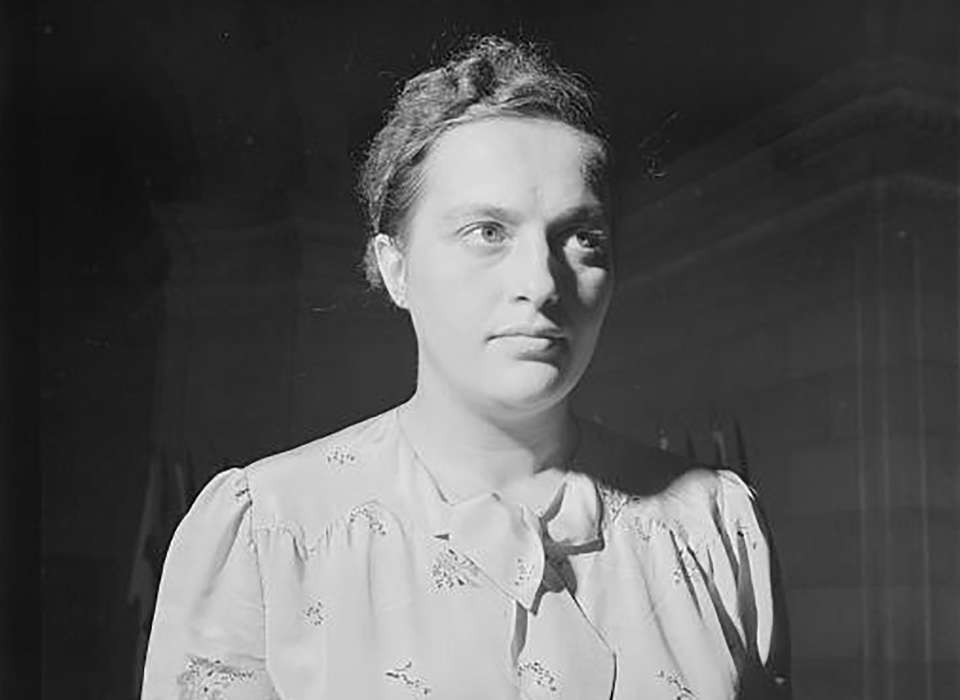
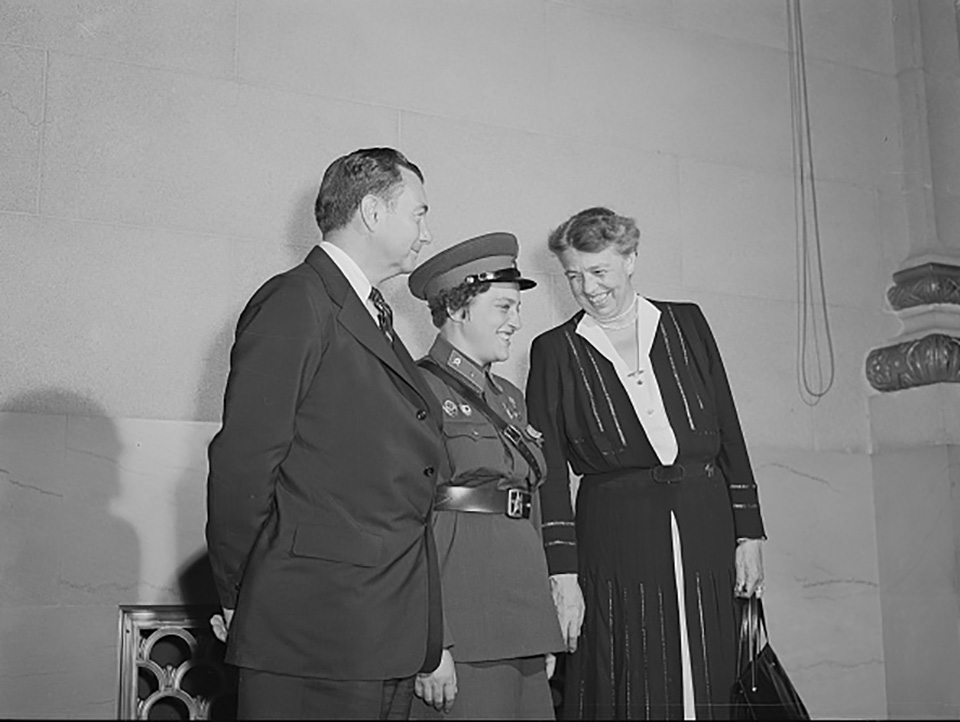
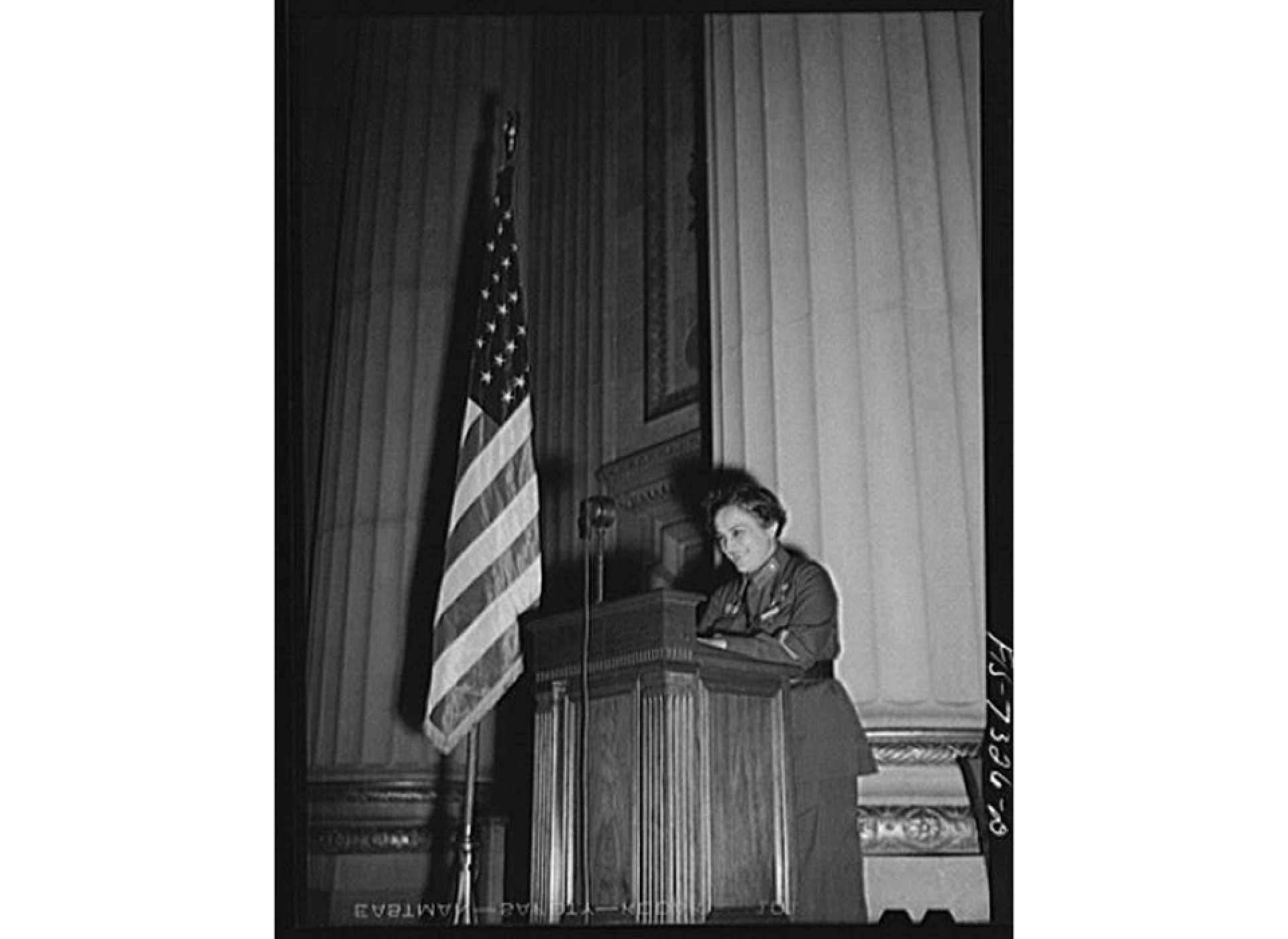
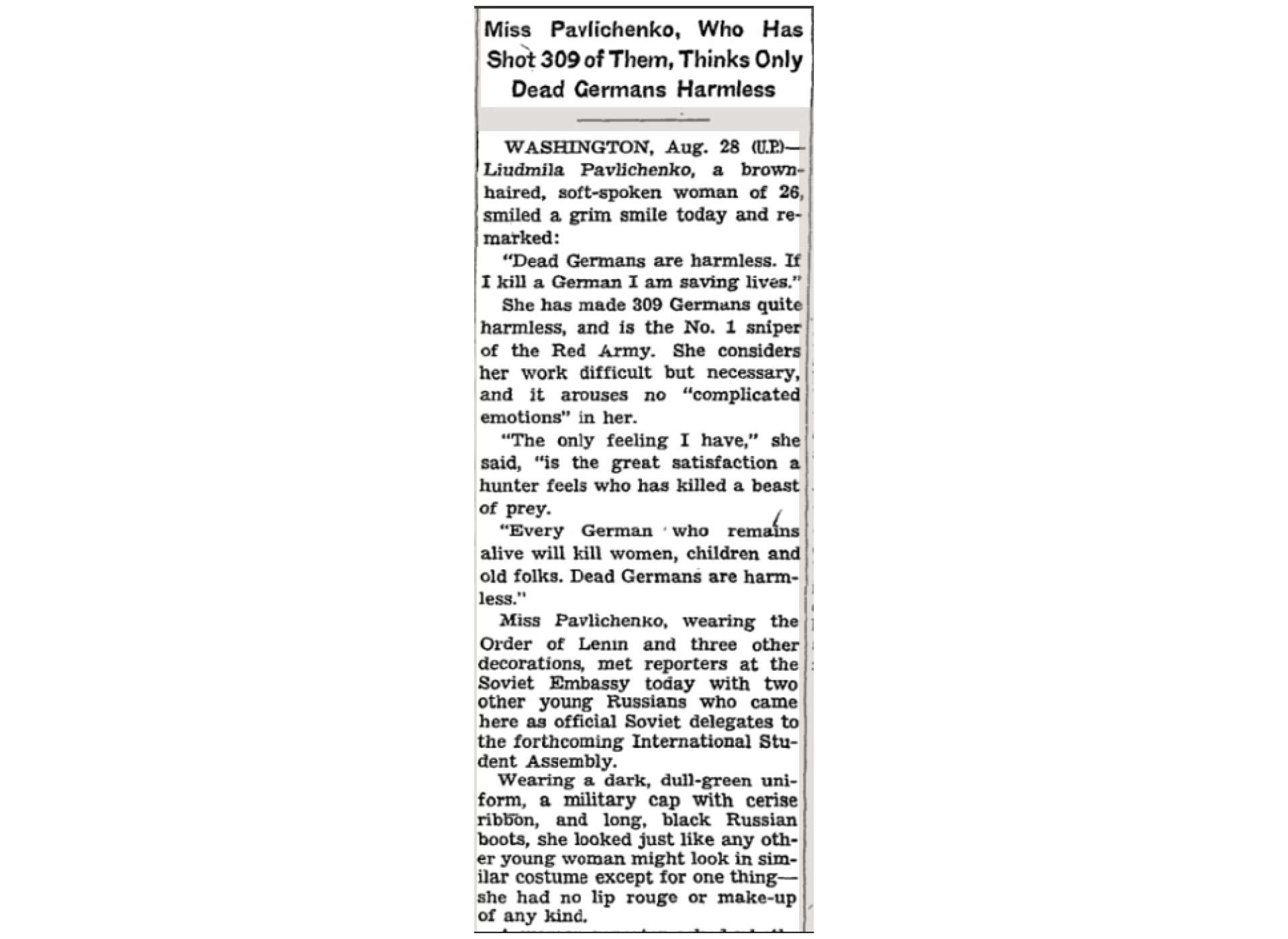
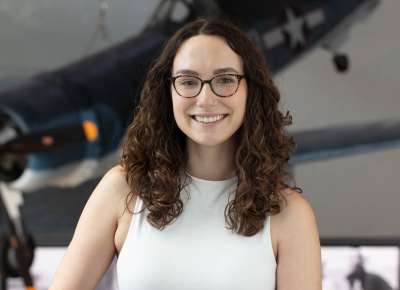
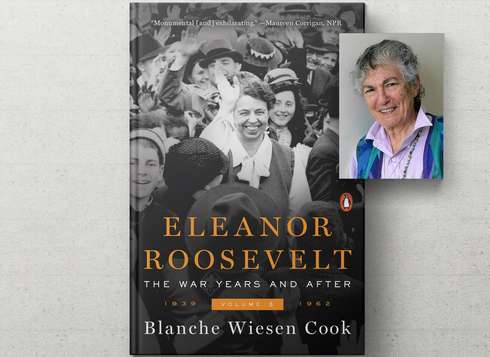
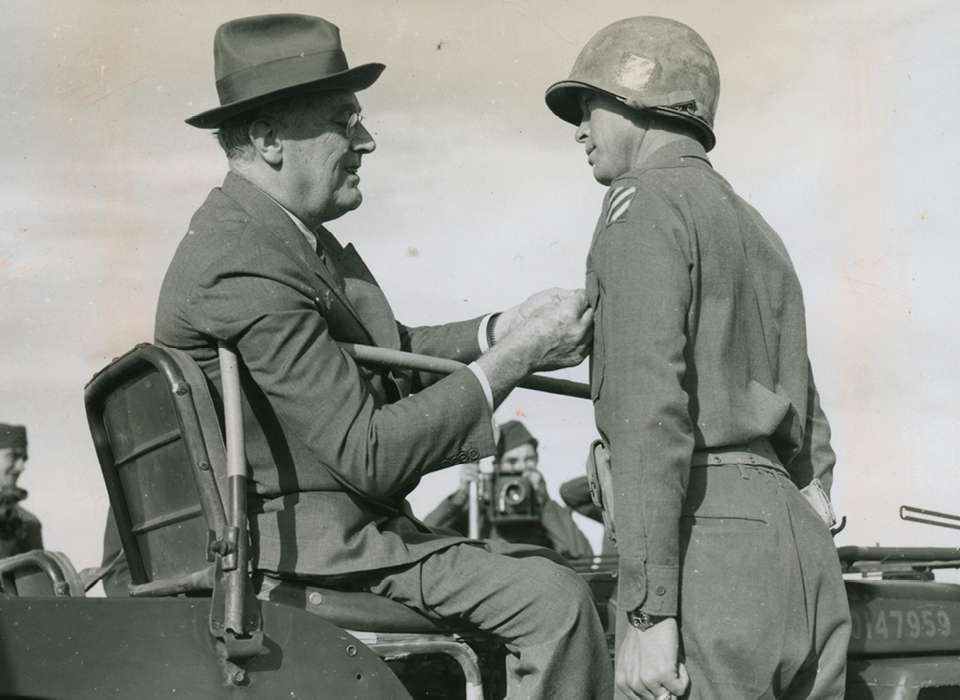



![Max Fuchs, New York City cantor, sings as Rabbi Sydney [sic] Lefkowitz, Richmond, VA, conducts the first Jewish services from Germany.](/sites/default/files/styles/max_650x650/public/2025-10/image1.jpg)



